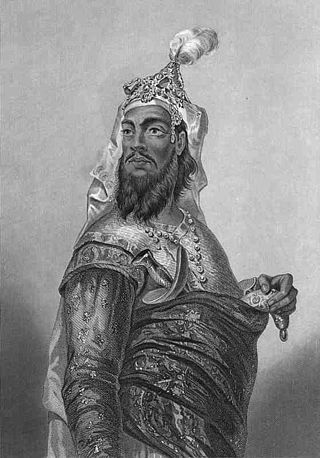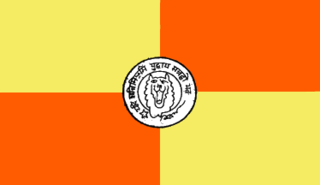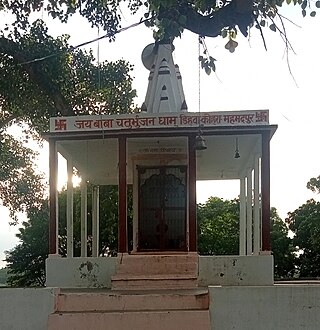Kuchesar was a Zamindari Estate of Dalal Jats during the British Raj. It is situated off the NH 24 in what is now of Bulandshahr district, Uttar Pradesh, India, 80 kilometres (50 mi) from Delhi.

Bhojpur district is one of the thirty-eight districts of the Indian state of Bihar. Arrah city is the administrative headquarters of this district. Bhojpur district came into existence in 1972. Earlier it was the part of Shahabad district. This district is named "Bhojpur" after great Parmara King Bhoja as most early settlers were Rajput rulers of Parmara dynasty then called as Ujjainiya.

Kunwar is an Indian title denoting a prince. It is derived from the Sanskrit word Kumar. It was traditionally associated with the feudal Rajputs such as the son of a Rana, Babu and Thakur

Babu Kunwar Singh was the Raja of Jagdishpur and leader of the revolt from the Bihar region during the Indian Rebellion of 1857. He led a selected band of armed soldiers against the British East India Company. He was the chief organiser of the fight against the British in Bihar.
Babu Amar Singh was the ruler of Jagdishpur and revolutionary in the Indian Rebellion of 1857. He was the brother of Babu Kunwar Singh, the Raja of Jagdishpur who was the chief organiser of 1857 revolt in Bihar against British government. He became the Raja of Jagdishpur, after the death of his elder brother, Kunwar Singh. He continued his battle against Britishers after his death.

Amethi is one of the 75 districts of the northern Indian state of Uttar Pradesh. This district is a part of Ayodhya division in the Awadh region of Uttar Pradesh. It covers an area of 2329.11 km2. Gauriganj is the administrative headquarters of the district.

Jagdishpur is a nagar panchayat town of the district Bhojpur of the state of Bihar in eastern India. It was the capital of the eponymous Jagdishpur estate, ruled by Rajputs of the Ujjainiya clan. One of its rulers, Kunwar Singh, was a major figure in the Indian Rebellion of 1857, considered the leader of the rebellion in Bihar.

The Ujjainiya Parmār or simply Ujjainiya is an Indian Rajput dynasty which originally constitute one of the major branch of the Paramara dynasty of Malwa. Members of the Ujjainiya clan historically ruled over the different region of Bihar and Purvanchal since the early 14th century. They are considered to have played a prominent role in the political history of medieval Bihar with many of their strongholds being established in the West Bihar and Purvanchal region, the most notable of which are Dumraon Raj and Jagdishpur.

SIIMA Award for Best Actor in a Negative Role – Telugu is presented by Vibri media group as part of its annual South Indian International Movie Awards, for the best acting done by an actor in a negative role in Telugu films. The award was first given in 2012 for films released in 2011.
Dildarnagar Kamsar or Kamsaar, is a Pargana or a region of 32 places around Karamnasa river in Ghazipur district, and Kaimur District of Uttar Pradesh, and Bihar, India. Of whom main mouzas being 19. It is a large settlement of pathans mostly Khanzada Pathans and Afghan Pathans.

Sultan Babullah, also known as Sultan Baabullah was the 7th Sultan and 24th ruler of the Sultanate of Ternate in Maluku who ruled between 1570 and 1583. He is known as the greatest Sultan in Ternatan and Moluccan history, who defeated the Portuguese occupants in Ternate and led the Sultanate to a golden peak at the end of the 16th century. Sultan Babullah was commonly known as the Ruler of 72 (Inhabited) Islands in eastern Indonesia, including most of the Maluku Islands, Sangihe and parts of Sulawesi, with influences as far as Solor, East Sumbawa, Mindanao, and the Papuan Islands. His reign inaugurated a period of free trade in the spices and forest products that gave Maluku a significant role in Asian commerce.
Kunwar Singh (1777–1858) was one of the leaders during the Indian Rebellion of 1857.
Hare Krishna Singh (1826-1858) was the commander-in-chief of Kunwar Singh's forces in the Indian Rebellion of 1857 and also served under his brother Babu Amar Singh.

Jagdishpur Raj was a zamindari fedual state in the erstwhile Shahabad district of modern-day Bihar, India ruled by the members of Ujjainiya dynasty. The capital of the estate was the town of Jagdishpur, and the estate included all neighbouring towns and villages. The estate was also protected by a fort.
Rana Beni Madho or Beni Madho Baksh Singh Bais was one of the most important leaders in the Indian rebellion of 1857 from the Oudh region. He belonged to the Bais clan of Rajputs and was the ruler of the Shankarpur estate in modern-day Rae Bareli, part of the old Baiswara region in Oudh. He led a rebellion against the British forces in 1857. His son was married to the grand daughter of another prominent revolutionary leader Kunwar Singh of Jagdishpur estate.

Kohra was an estate (taluqdari) of Oudh, British India. The taluqdari was controlled by the Bandhalgoti clan of Rajputs. Now it is part of Amethi district in Uttar Pradesh, India.
Babu Bhoop Singh was the ruler of Kohra (estate) of Oudh, British India from 1840 to 1890 and belongs from Bandhalgoti clan of Rajput. He was leader in the Indian Rebellion of 1857. He led a rebellion against the British forces in 1857. He was involved in the War of Awadh of 1857 and the siege of Lucknow residency and to stop Colonel Wroughton, he fought battles at Chanda, Amhat and Kadunala in Sultanpur district. His property was taken under the management of Court of Wards in 1859. On order of Calcutta High Court, by government removed Court of Wards from Kohra in 1870. Later estate was ruled by Babu Shiv Dayal Singh.

Kohra is a village in Amethi tehsil of Amethi district in the Indian state of Uttar Pradesh. Kohra was historically the seat of a large Taluqdari estate held by a leading branch of the Bandhalgoti Rajputs. As of 2011, it has a population of 4,407 people, in 786 households.

Bandhalgoti is a clan of Kachwaha Rajputs found mainly in Amethi-Sultanpur region of Uttar Pradesh. Bandhalgoti Rajputs ruled a number of estates including Amethi, Kohra and Shahgarh etc. which lie in present-day Uttar Pradesh.









